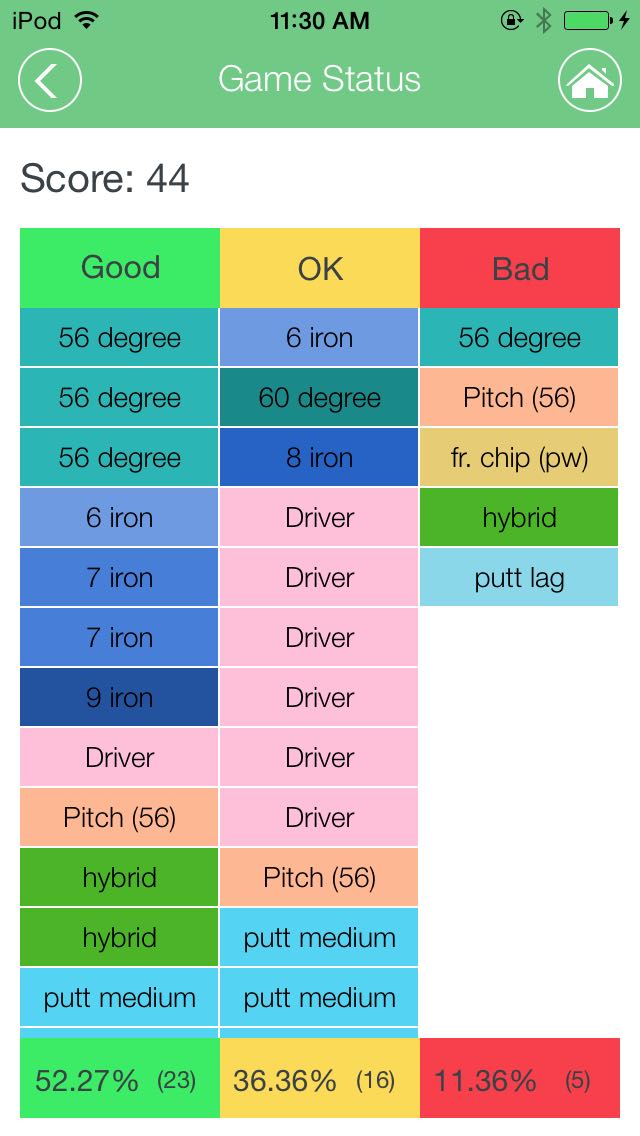Watching golf on TV, you will hear them talk about “Strokes Gained Putting”. That is only one piece of what Strokes Gained analysis can be used for. It’s a very simple, yet extremely useful way to understand every part of your golf game. Here is how simple the math is. Suppose you are 150 yards from the hole on Monday, and it takes you 1 shot to the bunker, one out of the bunker, and 2 putts to complete the hole for a total of 4 shots to hole out from 150 yards. On Tuesday, from 150 yards you hit the green and two-putt for a total of 3 shots to hole-out from 150 yards. If you take the average of how many strokes it took on Monday and Tuesday, the average it took you to get into the hole from 150 yards was 3.5 strokes. On Wednesday, you again hit the green from 150 yards and 2 putt. You holed out in 3 shots. How was that shot compared to your AVERAGE from 150 yards? 0.5 strokes. On Wednesday, that particular shot was 1/2 stroke better than your average so you gained 0.5 strokes for that particular shot. Averages from two days are not that significant, but I use that as an example. The averages used typically come from averaging thousands of shots.
This is used by the pros extensively, but they average for almost all golf pros for all distances from all courses for many years. They then compare how the golfer did on a shot, a hole, a round, or a tournament to this average from a massive number of recorded strokes by the PGA tour. If you do this for all golfers on that day or for that tournament, compare them to the average for thousands of distances, you can directly compare different golfers to the same measuring stick, that average from tens of thousands of shots from specific distances. Why is this useful for pros? Traditional stats can be misleading. Recording how many greens hit and how many putts is not a great way to compare golfers, because it depends how close you are to the pin for greens in regulation. If one golfer is knocking the ball within 6 feet all day, of course he has fewer putts than the golfer that is on the green but 30 ft from the pin. Strokes Gained takes away some of this ambiguity in traditional golf stats.
So what? How does that help me?
The same can be done but averaging amateur golfers, and you can restrict that average to golfers of the same handicap. You can then compare any shot from any distance to this average of golfers of your skill level and compare objectively the quality of the shot. A quick calculation can determine how many strokes you lost that day for various distances, then focus your practice time on where you lost strokes and not waste limited practice time on shots you are good at.
The 80BREARK golf app’s Game Improvement feature uses this same idea: don’t waste time practicing shots you are good at, find out and work on the shots you recorded as “bad” during a round. Strokes Gained takes this one step further and gives exact numbers calculated to determine how good or how bad a shot is. For instance, in this particular round, I had a poor 56 degree, a poor pitch & chip, a bad lag putt, and a bad hybrid. Strokes Gained analysis could give me a number quantifying how many strokes I lost on each bad shot. If I had only a couple of chances to practice, I could focus on the shots needing the most work.
Strokes Gained is a very simple and powerful concept that we’re bringing to 80BREAKR soon! We’re developing a unique approach to Strokes Gained we call eSG, for Equipment Strokes Gained analysis. Our approach focuses on shot types with specific clubs. The advantage to this approach is of particular use to the amateur. Traditional Strokes Gained analysis does not care if you hit a flop shot just off the green, or an 8 iron bump and run. In our view, this is important. Are you losing strokes with a lob shot or a bump and run? Likewise, for the short par 5 with OB right, are you gaining or losing strokes using your 3 wood off the tee vs. your driver? Is that new putter making any difference at all? For a pro, these issues may be better evaluated in their typical 40 or 50 hour practice week. For the amateur, knowing your strengths and weaknesses before that green-side shot or when standing on the tee can help you make a better decision. It’s also a way to help focus your practice and help you find your pot of gold: breaking your own personal best score in golf!

